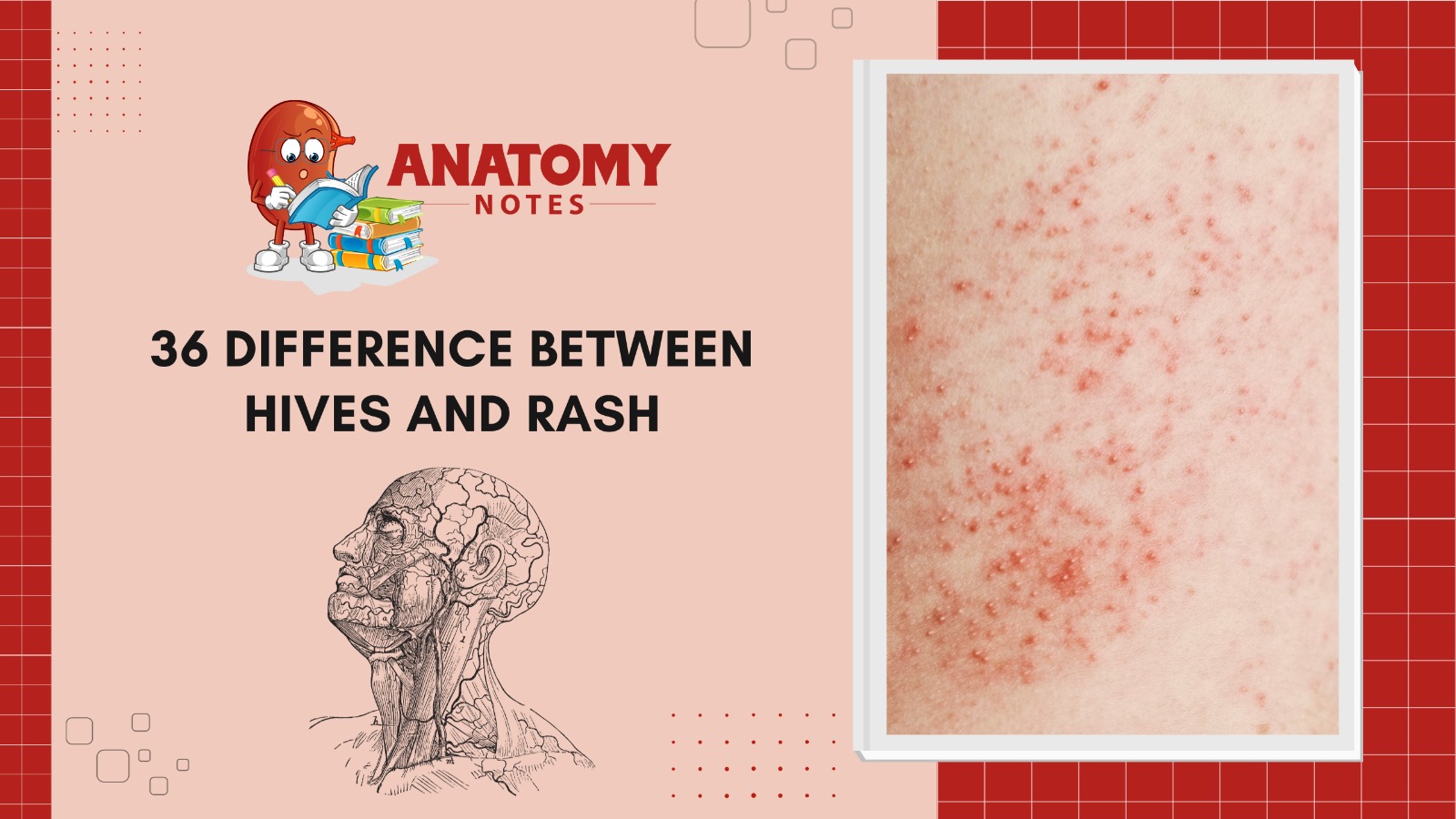Hives and rashes are common skin disorders that can be uncomfortable, but they differ. Hives, also known as urticaria, are red or pink, itchy welts on the skin. Welts can vary in size and form and arise quickly, lasting hours or a day before vanishing. Allergic reactions to meals, drugs, insect stings, or pollen generally cause them. Occasionally, stress and illnesses can cause hives. Hives are fast, ephemeral, and cause new welts as old ones recede.
Rashes, on the other hand, include redness, irritation, itching, and textural changes. Rashes can be caused by allergies, infections, autoimmune illnesses, and irritants like textiles or chemicals. Rashes grow slowly and may last longer than hives. They can be blotchy, bumpy, scaley, or blistery, depending on the etiology. Rash appearances vary more than hives. Mechanistic differences distinguish them. In reaction to an allergen, histamines, and other substances cause blood vessel leaking and skin swelling in hives. However, inflammation, immunological reactions, infections, and skin irritation cause rashes.
Hives and rashes can be treated with over-the-counter antihistamines, corticosteroid creams, and other topical medications, but treating the source is essential for long-term management. A doctor should be seen for severe or chronic occurrences of either illness. Hives and rashes share itching and redness, but their origins, start patterns, and looks differ. Understanding these distinctions helps diagnose and treat.
Also Read: 32 Difference between Caesarian Section and Normal Birth
Here are 18 differences between hives and a rash:
|
S.No. |
Aspects |
Hives |
Rash |
|
1 |
Terminology |
Also known as urticaria |
Commonly referred to as a rash |
|
2 |
Appearance |
Raised, red, and itchy welts |
Variable appearance, flat or raised |
|
3 |
Texture |
Swollen, firm to the touch |
Can be smooth or rough |
|
4 |
Size |
Individual welts can change size |
Variable in size |
|
5 |
Shape |
Often irregularly shaped |
Can have various shapes |
|
6 |
Duration |
Typically short-lived (hours to days) |
Duration varies (hours to weeks) |
|
7 |
Itchiness |
Often intensely itchy |
May or may not be itchy |
|
8 |
Triggers |
Often triggered by allergies, stress, heat, or medications |
Various causes, including allergies, infections, and irritants |
|
9 |
Swelling |
May involve swelling of the skin |
May or may not involve swelling |
|
10 |
Lesion Evolution |
Individual welts may come and go |
Rash may evolve or persist |
|
11 |
Elevation |
Raised above the surrounding skin |
May or may not be raised |
|
12 |
Distribution |
Can appear anywhere on the body |
May have specific distribution patterns |
|
13 |
Allergic Reaction |
Often associated with allergies |
May or may not be allergy-related |
|
14 |
Systemic Symptoms |
Rarely associated with systemic symptoms |
Can be associated with fever, pain, etc. |
|
15 |
Treatment |
Antihistamines are often effective |
Treatment varies based on the underlying cause |
|
16 |
Chronic Forms |
Chronic urticaria can persist for months |
Chronic rashes have prolonged duration |
|
17 |
Scarring |
Generally does not cause scarring |
Can lead to scarring in some cases |
|
18 |
Underlying Mechanism |
Caused by the release of histamine |
Caused by various underlying mechanisms |
Also Read: Structure of skin – A Creature of Epidermis, Dermis and Hypodermis
Frequently Asked Questions (FAQS)
Q.1 What causes hives to develop?
Hive (urticaria) usually results from allergic reactions to stimuli. These triggers include nuts, shellfish, dairy, antibiotics, painkillers, insect stings, pollen, pet dander, and stress. The body produces histamines and other substances in reaction to allergens, causing raised, itchy welts.
Q.2 Do allergic reactions usually cause rashes?
Rashes are caused by several things besides allergies. Rashes can be caused by allergies, infections (like fungal or bacterial), skin irritants (such as chemicals or textiles), autoimmune diseases, and genetic susceptibility. Rash causes are more complicated to identify than hives due to their variety.
Q.3 How do I differentiate between hives and a rash?
Hives are abrupt, cause raised welts that may emerge and dissipate within hours, and travel across the body. They vary in size and form and are very irritating. However, rashes might be redness, pimples, blisters, or scales. They may grow slowly and dissipate slower than hives. To identify the two, a medical assessment must determine the cause.
Q.4 Can stress really cause hives?
Stress can cause hives in certain people. Stress generates chemicals that can cause skin changes, including hives. This is called “stress hives” or “stress urticaria.” Managing stress with relaxation and lifestyle modifications can minimize stress-induced hives.
Q.5 Should I seek medical attention for hives or rashes?
Hives and rashes may often be treated with over-the-counter antihistamines or topical treatments. If the symptoms are severe, persistent, or accompanied by additional concerns including trouble breathing, swelling of the face or lips, or fever, get medical assistance immediately. A doctor can precisely diagnose the reason and provide the right medication, assuring comfort and preventing consequences.




